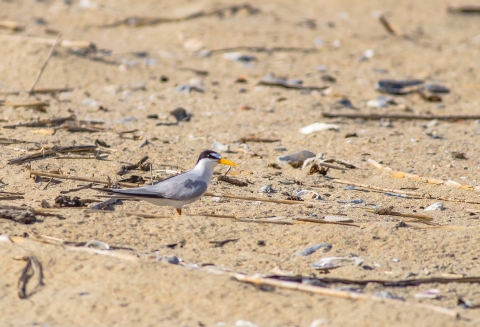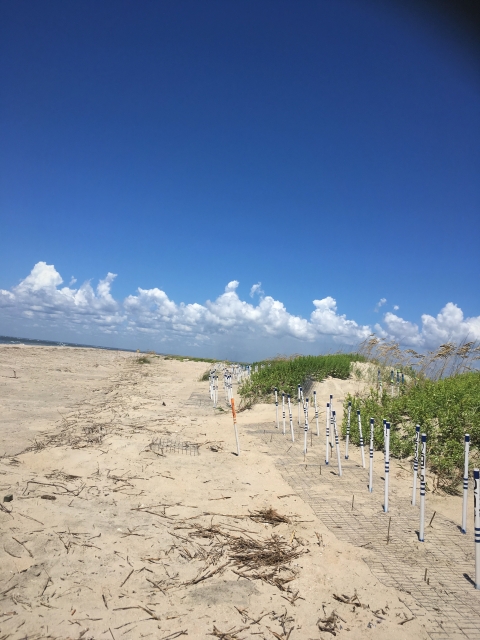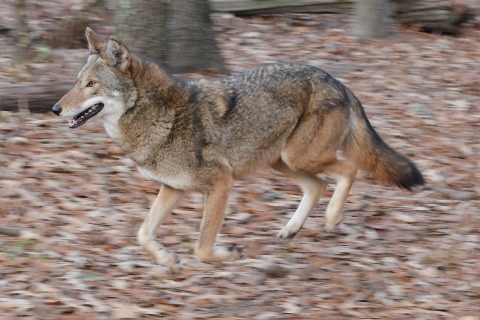Seasons of Wildlife
Winter – American wigeon, gadwall, teal, scotor, bufflehead, ruddy ducks and other waterfowl species find safe haven. The American oystercatcher with its bright red-orange bill is easily spotted on shell bars and sand flats in the salt marsh salt marsh
Salt marshes are found in tidal areas near the coast, where freshwater mixes with saltwater.
Learn more about salt marsh . Oystercatchers are common year round, with the largest wintering population of American oystercatchers along the Atlantic and Gulf coasts found in the refuge. On Bulls Island, black fox squirrels, recognized by their white ear tips and nose patch, are busy breeding and frequently sighted on service roads and open forest areas. In late winter, the elusive bobcat is mating, finding shelter in the dense evergreens of the maritime forest.
Spring – A myriad of migratory songbirds, shorebirds and seabirds arrive, some to rest and feed during migration and others to find suitable areas to breed. The colorful painted bunting, summer tanager, and orchard oriole return to nest in the forest. Black skimmers, wilson’s plovers, American oystercatchers and least terns are on beaches and black-neck stilts find nesting sites close to shallow ponds. In late spring, Loggerhead sea turtles start arriving and American alligators begin their courtships on Bulls Island. Spring peepers, chorus frogs and other tree frogs sing and call for mates. Strikingly patterned diamondback terrapins nest in sandy substrates of the salt marsh.
Summer – Under the cover of darkness, Loggerhead sea turtles come up to the beaches and dig deep nests to deposit their eggs. Throughout the summer months, many species of birds are busy nesting and fledging their young. Alligators are constructing mounded nests of mud and vegetation in preparation for their young in late summer. With the high temperatures of summer, mosquitoes, deer flies, chiggers and other insects are abundant.
Fall – During the fall, watch for the powerful and swift aerial maneuvers of the peregrine falcon and merlin as they look for prey below. Migratory songbirds, shorebirds and seabirds leave for wintering areas but many year round species remain, especially herons, egrets, gulls and terns, plovers and sandpipers. In late fall, ducks begin to arrive in preparation for their winter stay. White-tailed deer are frequently sighted on Bulls Island, especially in fall and early winter months as bucks are chasing does during this courtship season.
Featured Species
Cape Romain NWR is a significant region of the southeastern United States, providing nesting, foraging and stopover habitats for large numbers of waterbirds and, is designated critical habitat for both the Piping plover and Red knot. Scientific data confirm that the Cape Romain-Santee Delta Region site is a rest stop for 100,000 migratory shorebirds every year. Cape Romain supports migratory seabirds and shorebirds like the Least tern, Black skimmer, Wilson's plover, American oystercatcher and many others. Today, refuge beaches annually support 51% of all of the seabird nesting in South Carolina. Cape Romain's Marsh Island is one of four nesting sites on the coast of South Carolina that supports large numbers of colonial seabird nesting and a large number of migrating shorebirds, providing undisturbed roosting habitat for the shorebirds within the refuge at night. The highest densities of nesting for two shorebirds in South Carolina, the American oystercatcher and Wilson's plover, occurs in Cape Romain. The refuge and surrounding Cape Romain region supports almost 2,000 oystercatchers in the winter, almost 15% of the estimated American oystercatcher population on the U.S. Atlantic and Gulf coasts. The Wilson's plover and American oystercatcher are both species of conservation concern and listed as high priority in regional shorebird conservation. Additionally, the refuge supports 54% of the Least terns in South Carolina, the largest number of natural nesting Least terns in the state as development has forced the terns to rooftops.
Cape Romain's barrier island beaches are crucial to the protection of the threatened Loggerhead sea turtle and, the refuge supports the largest nesting northern population of the Loggerhead turtle outside of the state of Florida. This population consists of those turtles which nest from North Carolina to around Cape Canaveral, Florida. They are isolated from all other nesting turtles in the southeast based on genetic studies involving mitochondrial DNA. Earlier years have averaged 1000 nests annually; however, with nest records in recent years, the average number of nests on the refuge is climbing to 2000 annually. Loggerhead turtle nest monitoring and management activities at Cape Romain NWR began in 1979 with the listing of the species. The nest recovery project involves daily recording of nests and false crawls (turtle was on beach but did not nest), nest relocation if in danger of overwash, caging to protect from predators, and nest inventories. The refuge participates in the Sea Turtle Stranding and Salvage Network, which is part of a multi-regional network coordinated by the National Marine Fisheries Service. Members of the network in South Carolina include SC Department of Natural Resources, U.S. Fish and Wildlife Service and private citizens. The South Carolina Aquarium takes live sea turtles for rehabilitation at its Sea Turtle Care Center. Here, sick and injured sea turtles are monitored and treatments and rehabilitative care is provided. When deemed healthy enough to survive on its own, the turtle is returned to the ocean where it can rejoin the population. The refuge also participates in genetics recovery research, an ongoing multi-state project that began in 2010 and includes South Carolina, Georgia and North Carolina. This research uses DNA genetic fingerprinting to identify individual Loggerhead nesting females, information that will provide a census of the actual nesting population. You can learn more about Loggerhead nesting in Cape Romain NWR, sea turtle stranding, and genetics research at SEATURTLE.ORG. Since 2008, private donations from the Dewees Island Property Owners Association have supported interns to assist staff with the nest recovery project at the refuge. With the help of these interns and a cadre of volunteers, the refuge is able to continue Loggerhead nest protection at Cape, Lighthouse and Bulls Islands.
The Red Wolf is one of two species of wolves in North America, the other being the Gray Wolf. Red Wolves are protected as an endangered species under the Endangered Species Act (ESA), except in northeastern North Carolina where it was reintroduced at Alligator River National Wildlife Refuge as a nonessential experimental population in 1987, the only known wild population of Red Wolves. The Red Wolf is classified as "critically endangered" on the International Union for Conservation of Nature's (IUCN) Red list. For more than 30 years, the U.S. Fish and Wildlife Service and its partners have been working to conserve and recover the Red Wolf. Managment for the wild Red Wolf in North Carolina includes the release of additional Wolves on the Albemarle Peninsula and adaptive practices such as coyote sterilization and limited authorized take by private citizens. The Red Wolf Coalition in North Carolina provides current news reports, research information, and educational materials for youth.
Cape Romain NWR has been and continues to be an active participant in the Red Wolf Species Survival Plan, a captive breeding program established in the early 1970s to increase the Red Wolf population size and reestablish the Red Wolves in portions of their historic range. The refuge visitor center, Sewee Visitor and Environmental Education Center, has housed Red Wolves since 1997 and is one of over 50 captive breeding facilities nationwide. Historically, Cape Romain's Bulls Island has played an integral role in the recovery of the endangered Red Wolf. Due to its protected geographic location and prey base, Bulls Island was chosen as the experimental release site. In 1978, the 9-month successful release of two Red Wolves demonstrated the feasibility of reintroduction into the wild. Bulls Island became the first island breeding site in 1987 and, on April 23, 1988, two young males were born. In the following years, young pups would roam the island, learning basic survival skills before relocation into the wild at Alligator River National Wildlife Refuge. On April 18, 2004 the last island litter of four, three females and one male, was born. The island breeding program closed in 2005. From 1987 to 2005, 26 Red Wolf pups were born at Bulls Island. Currently, the U.S. Fish and Wildlife Service island project continues at St. Vincent National Wildlife Refuge.










